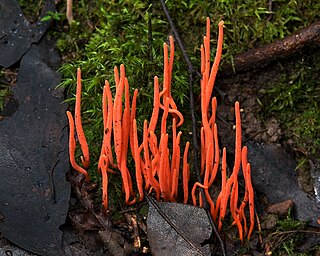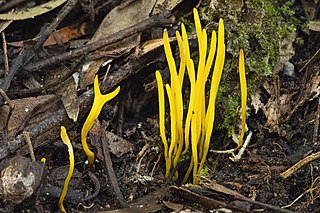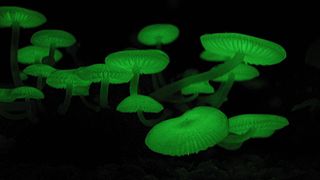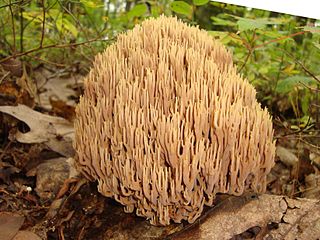
The Clavariaceae are a family of fungi in the order Agaricales. Originally the family contained most of the clavarioid fungi, but in its current sense is more restricted, albeit with a greater diversity of basidiocarp forms. Basidiocarps are variously clavarioid or agaricoid (mushroom-shaped), less commonly corticioid or hydnoid.

Ramariopsis is a genus of coral fungi in the family Clavariaceae. The genus has a collectively widespread distribution and contains about 40 species. The name means 'having the appearance of Ramaria'.

Ramariopsis kunzei is an edible species of coral fungi in the family Clavariaceae, and the type species of the genus Ramariopsis. It is commonly known as white coral because of the branched structure of the fruit bodies that resemble marine coral. The fruit bodies are up to 5 cm (2.0 in) tall by 4 cm (1.6 in) wide, with numerous branches originating from a short rudimentary stem. The branches are one to two millimeters thick, smooth, and white, sometimes with yellowish tips in age. Ramariopsis kunzei has a widespread distribution, and is found in North America, Europe, Asia, and Australia.

Clavaria is a genus of fungi in the family Clavariaceae. Species of Clavaria produce basidiocarps that are either cylindrical to club-shaped or branched and coral-like. They are often grouped with similar-looking species from other genera, when they are collectively known as the clavarioid fungi. All Clavaria species are terrestrial and most are believed to be saprotrophic. In Europe, they are typical of old, mossy, unimproved grassland. In North America and elsewhere, they are more commonly found in woodlands.

The clavarioid fungi are a group of fungi in the Basidiomycota typically having erect, simple or branched basidiocarps that are formed on the ground, on decaying vegetation, or on dead wood. They are colloquially called club fungi and coral fungi.

Clavaria fragilis, commonly known as fairy fingers, white worm coral, or white spindles, is a species of fungus in the family Clavariaceae. It is synonymous with Clavaria vermicularis. The fungus is the type species of the genus Clavaria and is a typical member of the clavarioid or club fungi. It produces tubular, unbranched, white basidiocarps that typically grow in clusters. The fruit bodies can reach dimensions of 15 cm (5.9 in) tall by 0.5 cm (0.2 in) thick. Clavaria fragilis is a saprobic species, growing in woodland litter or in old, unimproved grassland. It is widespread throughout temperate regions in the Northern Hemisphere, but has also been reported from Australia and South Africa. The fungus is edible, but insubstantial and flavorless. There are several other small white coral-like fungi with which C. fragilis may be confused.

Clavaria zollingeri, commonly known as the violet coral or the magenta coral, is a widely distributed species of fungus. It produces striking tubular, purple to pinkish-violet fruit bodies that grow up to 10 cm (3.9 in) tall and 7 cm (2.8 in) wide. The extreme tips of the fragile, slender branches are usually rounded and brownish. A typical member of the clavarioid or club fungi, Clavaria zollingeri is saprobic, and so derives nutrients by breaking down organic matter. The fruit bodies are typically found growing on the ground in woodland litter, or in grasslands. Variations in branching and color can often be used to distinguish C. zollingeri from similarly colored coral fungi such as Alloclavaria purpurea and Clavulina amethystina, although microscopy is required to reliably identify the latter species.

Clavariadelphus ligula, commonly known as the strap coral, is a species of fungus in the family Gomphaceae. It produces club-shaped fruit bodies with spongy flesh that grow in groups on the forest floor. It is found in Asia, Europe, and North America.

Thelephora palmata is a species of clavarioid fungus in the family Thelephoraceae. The fruit bodies are leathery and coral-like, with branches that are narrow at the base before widening out like a fan and splitting into numerous flattened prongs. The wedge-like tips are whitish when young, but darken as the fungus matures. The common names of the fungus refers to its pungent odor, likened to fetid garlic. A widely distributed but uncommon species, it is found in Asia, Australia, Europe, North America, and South America, where it fruits on the ground in both coniferous and mixed forest.

Clavulinopsis amoena is a clavarioid fungus in the family Clavariaceae. It forms slender, cylindrical, golden-yellow fruiting bodies that grow on the ground among plant litter. It was originally described from Indonesia and appears to be distributed in temperate areas of the southern hemisphere.

Mycena chlorophos is a species of agaric fungus in the family Mycenaceae. First described in 1860, the fungus is found in subtropical Asia, including India, Japan, Taiwan, Polynesia, Indonesia, and Sri Lanka, in Australia, and Brazil. Fruit bodies (mushrooms) have pale brownish-grey sticky caps up to 30 mm (1.2 in) in diameter atop stems 6–30 mm (0.2–1.2 in) long and up to a millimeter thick. The mushrooms are bioluminescent and emit a pale green light. Fruiting occurs in forests on fallen woody debris such as dead twigs, branches, and logs. The fungus can be made to grow and fruit in laboratory conditions, and the growth conditions affecting bioluminescence have been investigated.

Ramaria stricta, commonly known as the strict-branch coral is a coral fungus of the genus Ramaria. It has a cosmopolitan distribution, and grows on dead wood, stumps, trunks, and branches of both deciduous and coniferous trees. Its fruit body is up to 10 cm tall, made of multiple slender, compact, and vertical parallel branches. Its color is typically light tan to vinaceous-brown. All parts of the mushroom will bruise when handled. There are several lookalike corals that can usually be distinguished from R. stricta by differences in coloration, bruising reaction, or microscopic features. The fungus is inedible due to its unpleasant odor and bitter taste.

Clavulinopsis helvola is a clavarioid fungus in the family Clavariaceae. In the UK, it has the recommended English name of yellow club. It forms slender, cylindrical, yellow fruiting bodies that grow on the ground in agriculturally unimproved grassland or in woodland litter. It was originally described from Europe.

Clavulinopsis fusiformis is a clavarioid fungus in the family Clavariaceae. In the UK, it has been given the recommended English name of golden spindles. In North America it has also been called spindle-shaped yellow coral or golden fairy spindle. Clavulinopsis fusiformis forms cylindrical, bright yellow fruit bodies that grow in dense clusters on the ground in agriculturally unimproved grassland or in woodland litter. It was originally described from England and is part of a species complex as yet unresolved.

Clavulinopsis laeticolor is a clavarioid fungus in the family Clavariaceae. In the UK, it has the recommended English name of handsome club. It forms slender, cylindrical, yellow fruit bodies that grow on the ground in woodland litter or in agriculturally unimproved grassland. It was originally described from Cuba and is part of a species complex as yet unresolved.

Ramaria gracilis is a species of coral fungus in the family Gomphaceae.

Clavulinopsis sulcata is a clavarioid fungus in the family Clavariaceae and is the type species of the genus Clavulinopsis. It forms very long, slender, cylindrical pinkish or orange fruiting bodies that grow on the ground among plant litter.

Nigroporus vinosus is a species of poroid fungus in the family Steccherinaceae, and the type species of the genus Nigroporus. Its fruit bodies have brownish caps with tinges of purple or red. The cap underside has a pore surface the same colour as the cap, and minute pores. Nigroporus vinosus has a pantropical distribution. It has been recorded from Africa, North America, Central America, South America, Asia, and Oceania. It is a wood-decay fungus that causes a white rot.

Clavulinopsis corniculata is a clavarioid fungus in the family Clavariaceae. In the UK, it has the recommended English name of meadow coral. It forms branched, cylindrical, ochre fruit bodies that grow on the ground in agriculturally unimproved grassland or in woodland litter. It was originally described from Germany and is part of a species complex as yet unresolved.

Clavulinopsis aurantiocinnabarina is a clavarioid fungus in the family Clavariaceae. It has been given the English names of orange spindle coral or orange worm coral. It forms cylindrical, orange fruit bodies that grow on the ground in woodland litter. It was originally described from the United States and is part of a species complex as yet unresolved.

















